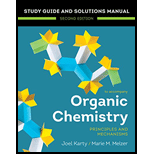
(a)
Interpretation:
The number of chiral centers in
Concept introduction:
A chiral center is an
(b)
Interpretation:
The enantiomer of the
Concept introduction:
Enantiomers are molecules that are nonsuperimposable mirror images. Specific rotations of enantiomers are equal, but of opposite signs.
(c)
Interpretation:
It is to be determined how the two enantiomers are related apart from being mirror images of each other. It is to be explained why they do not readily interconvert.
Concept introduction:
Conformers are molecules that can be interconverted by a rotation about a single bond.
If the rotation about the bond is restricted because of steric hindrance, the two conformers can be separated.
Want to see the full answer?
Check out a sample textbook solution
Chapter 5 Solutions
Organic Chemistry: Principles And Mechanisms: Study Guide/solutions Manual (second)
- assign the stereochemical configuration of the selected tetrahedral carbon chiral centers (R, S or N (not a chiral center)) and the alkene (E, Z or N (not a stereocenter)) that are indicated by the arrows (note that you do not have to assign the configuration of every chiral center in the molecule). If the atom in question is not a chiral center or is not a stereocenter circle N for neither.arrow_forwardAssign the absolute configuration to each chiral centers (signed with *).arrow_forwardShown is one isomer of 2,4-dibromo-1,3,5-triethylcyclohexane. Draw the most stable chiral stereoisomer of this compound, in its most stable conformation.arrow_forward
- Draw each compound in its most stable conformation(s). Then draw it in its most symmetric conformation, and determine whether it is chiral. trans-1,2-dibromocyclohexanearrow_forwardConsider the pair of compounds shown below then select the word or phrase that best describes the relationship between them.. Me H OH H Me OH and H OH Me Me They are diastereoisomers, but differ in their conformations. O They are constitutional isomers that, by definition, differ in their conformations. None of these are accurate. They are identical, but differ in their conformations. O They are enantiomers, but differ in their conformations.arrow_forward3. Which of the following compounds is (are) chital? Circle all that apply and assign R or S on the chiral center. II III IV 1arrow_forward
- Although we learned in Section 5.4 that uncharged nitrogen atoms generally cannot be chiral centers (due to nitrogen inversion), an exception is Tröger's base. Tröger's base has two enantiomers that can be separated from each other. They are different in their configurations at the N atoms. One enantiomer is shown on the right, viewed from two different perspectives. (a) Draw the second enantiomer of Tröger's base. (b) Explain why the two enantiomers do not interconvert. Tröger's basearrow_forward1. Menthol is a member of the terpene family of natural products. It exists in a (1R,2S,5R) form and a (1S, 2R, 5S) form. Draw the two molecules in their most stable chair conformer(s). Are these two compounds enantiomers or diastereomers? ОНarrow_forwardDetermine whether each of the following names describes a single stereoisomer unambiguously. For each one that does,rewrite the name using the R and S designations for the chiral centers if appropriate. (a) cis-1,2-difluorocyclohexane;(b) trans-1,2-difluorocyclohexane; (c) trans-1,4-difluorocyclohexane; (d) cis-1-chloro-2-fluorocyclohexane; (e) trans-1,4-dimethylcycloheptanearrow_forward
- Label the following pairs as A) distereoisomers, B) enantiomers, C) conformers, or D) the same. b1 c1 d1 e1 a2 b2 c2 The structures above are labeled a1, a2, b1, b2 ...etc. Using these labels, indicate which compounds above would have an optical rotation ofarrow_forwardDraw the two chair conformations of 1,1,3-trimethylcyclohexan ,and estimate the amount of strain energy in each. Which conformation is favoredarrow_forward3. Determine whether the following statements are true or false. Completely fill in the circle in front of your chosen answer. (a) A compound with a plane of symmetry must be achiral. (b) A compound with two or more stereocenters must be chiral. (a) O True O False True O Falsearrow_forward
 ChemistryChemistryISBN:9781305957404Author:Steven S. Zumdahl, Susan A. Zumdahl, Donald J. DeCostePublisher:Cengage Learning
ChemistryChemistryISBN:9781305957404Author:Steven S. Zumdahl, Susan A. Zumdahl, Donald J. DeCostePublisher:Cengage Learning ChemistryChemistryISBN:9781259911156Author:Raymond Chang Dr., Jason Overby ProfessorPublisher:McGraw-Hill Education
ChemistryChemistryISBN:9781259911156Author:Raymond Chang Dr., Jason Overby ProfessorPublisher:McGraw-Hill Education Principles of Instrumental AnalysisChemistryISBN:9781305577213Author:Douglas A. Skoog, F. James Holler, Stanley R. CrouchPublisher:Cengage Learning
Principles of Instrumental AnalysisChemistryISBN:9781305577213Author:Douglas A. Skoog, F. James Holler, Stanley R. CrouchPublisher:Cengage Learning Organic ChemistryChemistryISBN:9780078021558Author:Janice Gorzynski Smith Dr.Publisher:McGraw-Hill Education
Organic ChemistryChemistryISBN:9780078021558Author:Janice Gorzynski Smith Dr.Publisher:McGraw-Hill Education Chemistry: Principles and ReactionsChemistryISBN:9781305079373Author:William L. Masterton, Cecile N. HurleyPublisher:Cengage Learning
Chemistry: Principles and ReactionsChemistryISBN:9781305079373Author:William L. Masterton, Cecile N. HurleyPublisher:Cengage Learning Elementary Principles of Chemical Processes, Bind...ChemistryISBN:9781118431221Author:Richard M. Felder, Ronald W. Rousseau, Lisa G. BullardPublisher:WILEY
Elementary Principles of Chemical Processes, Bind...ChemistryISBN:9781118431221Author:Richard M. Felder, Ronald W. Rousseau, Lisa G. BullardPublisher:WILEY





